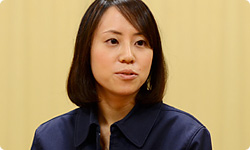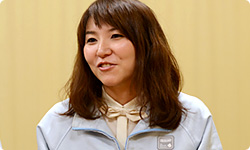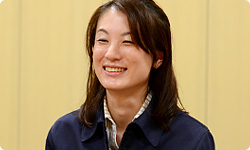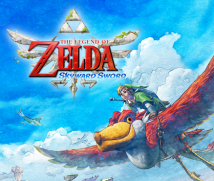2. Diehard Fans
Marunami-san and Hosaka-san, what did you think once you began working on The Legend of Zelda?
When I played The Legend of Zelda: The Wind Waker, I thought, “This isn’t just a cute game.” I felt like a lot of attention had been paid to detail around a hefty core of gameplay. For example, you can cut the grass, and whether it came to stones or a tree growing over there, if you do something, there’s sure to be some kind of response, which was pleasing.
There isn’t just unresponsive stuff sitting around taking up space.
Exactly. That is what is familiar about The Legend of Zelda.
If the player does something to some object, the game considerately responds and surprises. In our session of “Iwata Asks” on The Legend of Zelda: Ocarina of Time 3D, (Yoshiki) Haruhana-san called that Iwata Asks: The Legend of Zelda: Ocarina of Time 3D
That’s right. That kind of consideration is a part of the Legend of Zelda tradition, so when I made objects, I wanted them to provide a satisfying reaction.

How about you, Hosaka-san?
It’s the feeling of immersion, like I said before. For example, I noticed something when I played The Legend of Zelda: Twilight Princess. Link goes to help a young girl who gets kidnapped. She was his childhood friend. Was her name Ilia?
Yes.
After you rescue her, she matter-of-factly, says, “Thank you. Go on ahead.” The line is kept to the absolute minimum, but I was completely into it, so I thought, “Oh, come on! That’s all you’ve got to say?!” I was like (gesturing a hug), “Why aren’t you doing this?!” (laughs)
(laughs)
That’s how absorbed I was in the game, and when making the games, I try to find a way to create that kind of immersion. What I learned then was how each character in The Legend of Zelda is not completely determined at the beginning, but each person devises various things that...

The people making the game join forces in breathing life into the characters.
That’s right. I learned after starting to work on the games that the ideas of many staff members build up in the characters so that in the end they become vivid characters.
I see. Iwasaki-san, what is your history with The Legend of Zelda?
I always played The Legend of Zelda a lot. The first one I played was The Legend of Zelda: A Link to the Past.9 I got it when I was in primary school and thought, “This is fun!” 9The Legend of Zelda: A Link to the Past: An action-adventure game released for the Super Nintendo Entertainment System in November 1991 in Japan.
You’re a diehard Zelda fan.
That’s right. I loved it! (laughs) I played it for years - so much that I don’t know how many times I finished it! I got The Legend of Zelda: Ocarina of Time as soon as it came out, too, and again thought, “This is fun!”
Since you loved The Legend of Zelda so much, it must have been moving when you first began working on it.
It was. I was overjoyed, but I guessed it would be hard.
You were wondering, “Can I really make something like that which I enjoyed so much?”
Yes. I was worried about whether I could actually make something of that quality, but the only thing to do was give it my best. (laughs)

Did you discover anything once you did?
Like Marunami-san said, it’s pleasing when you casually try something out on an object and something happens. Looking at it as a game developer, there were a lot of times when I discovered something that one of my co-workers had slipped in without others knowing, and I thought, “That’s really getting into details!”
And you used that discovery in making the objects this time.
Yes.
How about you, Hirono-san?
The first game in the series that I played was The Legend of Zelda on the Nintendo Entertainment System.10 10The Legend of Zelda on the Nintendo Entertainment System: An action-adventure game released simultaneously with the Family Computer Disk System in February 1986 in Japan.
An even greater diehard fan of The Legend of Zelda! (laughs)
Yes. (laughs) And I played the Super Nintendo Entertainment System game, too. After that, there was a time when I didn’t play video games very much, but when The Legend of Zelda: Ocarina of Time came out for the Nintendo 64 system, a friend said, “It’s really cool!” so I tried playing it. I had never played a 3D game before, so I was shocked.
You jumped from the 2D world of The Legend of Zelda: A Link to the Past to the 3D world of The Legend of Zelda: Ocarina of Time and experienced something like culture shock.
Yes. I got totally into that world and played around with all sorts of things. For example, if there was a tree, I would run into it or strike it with the sword, and talk to the townspeople all the time, and if I found a Sheikah Stone11, I would send it flying for no reason! (laughs) 11Sheikah Stone: A stone in the game that will provide hints.

With a Bomb.
Yes. (laughs) They fly off like rockets, but gazing at one, I would think, “This is so fun...” Then once I joined the company, I became involved a little as staff on The Legend of Zelda: The Wind Waker and had the chance to watch from the side how they made the characters.
You watched those with more experience go about their work.
Yes. It felt like the characters were really alive. None of them simply talked.
(nodding in unison) Exactly!
As development went along, the characters would gain backgrounds and have more life breathed into them. I was surprised, thinking, “Oh, so that’s how you make them!” Something I tried to do in making the characters this time for The Legend of Zelda: Skyward Sword was making them feel familiar and be cute even if they looked weird. Like Marunami-san and Hosaka-san said, cuteness is a good hook.
And you made the characters rich, or “dense.”
Yes! (laughs) I paid attention to designing the characters to have an instantly memorable impact so that even if small children saw them, they would easily take to them.
That’s interesting. I asked about your experiences playing past Legend of Zelda games, and you mention, for example, how fun it was to launch Sheikah Stones!
Yes. (laughs)
And cut grass.
Yes! (laughs)
And wondering why Ilia didn’t hug you!
Yes! (laughs)
The Legend of Zelda is a game about using a sword to fight horrible monsters, but when I hear the comments from you girls, not a single one of you said anything like, “Defeating a tough monster felt so good!” I think that shows the broad range of The Legend of Zelda’s appeal.
(nodding in unison) We think so, too!
